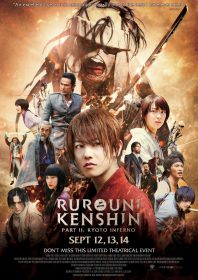
Solid if ambling sequel filmed back-to-back with part three, The Legend Ends, which delivers more spirited sword-fighting and zany characters from the world of popular manga, Rurouni Kenshin. Following the events of the first film, Kenshin (Takeru Satoh) – the pacifist samurai continuing his vow not to kill – is now living a utopian existence helping Kaoru (Emi Takei) to run her dojo, hanging out with tempestuous street-brawler Sanosuke – played by Munetaka Aoki, very much enjoying his comedic foil role – who might have a thing for their doctor neighbour, Megumi (Yū Aoi). It’s pretty obvious their idyllic life in post-shogunate Japan won’t last, and soon enough, the newly established police come knocking, recruiting Kenshin to stop a mad ronin from blowing up Kyoto. Makoto Shishio (Tatsuya Fujiwara) and his unholy gang, known as the ‘Ten Swords’, have jumped directly from the pages of a comic book: one of Shishio’s fighters has an outlandish blonde quiff, like Billy Idol; they live on a pirate ship; and Shishio himself is a ghoulish, mummified figure with burns all over his face and body. Like Kenshin, he too fought at the Battle of Toba-Fushimi, but was attacked, burned and left for dead by the very anti-shogunate forces he was working alongside. Now, as an embittered, vengeful samurai, he has formed his own army with a plan to overthrow the government and wreak havoc across the country. Kenshin puts his famous back-blade to good use in a series of highly kinetic action sequences which make clever use of camera positioning and wire-gags, while maintaining – for the most part – an anti-violence message. When it needs to get serious, the film delivers a shift in tone via a diverting subplot which essentially introduces a whole new set of characters. This includes a ninja, called Aoshi (Yūsuke Iseya), who has vowed to find and kill Kenshin who he distrusts for being a governmental stooge – and Aoshi’s now estranged former star pupil and love interest, Misao (Tao Tsuchiya), who is revealed to be a rather nifty kung fu fighter. The 1870s world-building is convincing and romantically shows a ‘new’ Japan in its imperialistic infancy, depicted as a place of enterprise, openness, and renewed power, facing an antiquated enemy from within which remains hostile to the new world and uncertain of their place within it. Kenshin represents the best of the old and the new; hopeful, adaptable to changes in society, keen to uphold justice and protect his friends, yet forever battling with his own instinctual bloodlust. He’s a fascinating if brittle ball of emotions. In contrast, the character of Kaoru is completely shortchanged this time around, and used purely as a motivational device to pull Kenshin into battle. Let’s hope Kaoru is given more agency in the follow-up.
AKA: Rurouni Kenshin 2; Rurouni Kenshin Part II: Kyoto Inferno.
- Country: Japan
- Action Director: Kenji Tanigaki
- Directed by: Keishi Ōtomo
- Starring: Emi Takei, Masaharu Fukuyama, Munetaka Aoki, Ryunosuke Kamiki, Takeru Satoh, Tao Tsuchiya, Tatsuya Fujiwara, Yōsuke Eguchi, Yū Aoi, Yûsuke Iseya
- Produced by: Satoshi Fukushima
- Written by: Keishi Ōtomo, Kiyomi Fujii
- Studio: Amuse, Gyao, KDDI Corporation, Shueisha, Warner Bros.












